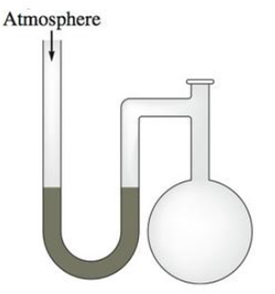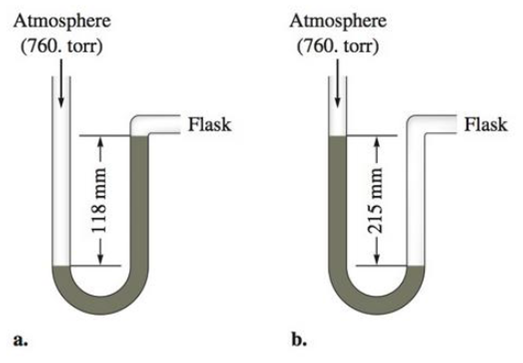
Concept explainers
A diagram for an open-tube manometer is shown below.

If the flask is open to the atmosphere, the mercury levels are equal. For each of the following situations where a gas is contained in the flask, calculate the pressure in the flask in torr, atmospheres, and pascals.

c. Calculate the pressures in the flask in parts a and b (in torr) if the atmospheric pressure is 635 torr.
(a)
Interpretation:
The pressure of the gases in given two situations of manometers (a) and (b) should be determined in units of torr, atm and pascals when the manometer shows a reading of 118mm and 215mm respectively. And also calculate the pressure of the gases in given two situations of manometers (a) and (b) If the atmospheric pressure is 635 torr.
Concept Introduction:
The manometer is a devise used measure the pressure of a gas. The pressure of gas is determined by the value of ‘h’ shown by the manometer. This ‘h’-value is added or subtracted with atmospheric pressure to determine the pressure of gas.
If the flask side mercury level is decreased after the filling of gas, then the ‘h’-value will be added to atmospheric pressure to get the pressure of gas.
If the flask side mercury level is increased after the filling of gas, then the ‘h’-value will be subtracted from the atmospheric pressure to get the pressure of gas.
The pressure equivalent of ‘h’ value is,
Pressure of a substance can be stated in various units. The units of pressure are interconvertible. The relations between units of pressure are,
- Since the unit mm Hg and the unit torr is used interchangeably.
- Conversion of 1 torr into atm is,
- The 1 mm Hg pressure in Pa unit is,
Answer to Problem 41E
The pressure of the given gas (figure-a) in units of torr, atm and pascal are,
642 torr, 0.8447 atm, 85593 Pa
Explanation of Solution
The given ‘h’ value for the gas in manometer is 118mm. The picture of manometer shows the flask side mercury level is increased after the filling of gas.
Hence the equation for finding the pressure of gas is,
That is,
=
=
The calculated pressure is 642 mm Hg; the mm Hg and torr units are used interchangeably,
Therefore,
The calculated pressure is 642mm Hg. So the pressure in atm unit is,
=
The calculated pressure is 642mm Hg. So the pressure in Pa unit is,
(b)
Interpretation:
The pressure of the gases in given two situations of manometers (a) and (b) should be determined in units of torr, atm and pascals when the manometer shows a reading of 118mm and 215mm respectively. And also calculate the pressure of the gases in given two situations of manometers (a) and (b) If the atmospheric pressure is 635 torr.
Concept Introduction:
The manometer is a devise used measure the pressure of a gas. The pressure of gas is determined by the value of ‘h’ shown by the manometer. This ‘h’-value is added or subtracted with atmospheric pressure to determine the pressure of gas.
If the flask side mercury level is decreased after the filling of gas, then the ‘h’-value will be added to atmospheric pressure to get the pressure of gas.
If the flask side mercury level is increased after the filling of gas, then the ‘h’-value will be subtracted from the atmospheric pressure to get the pressure of gas.
The pressure equivalent of ‘h’ value is,
Pressure of a substance can be stated in various units. The units of pressure are interconvertible. The relations between units of pressure are,
- Since the unit mm Hg and the unit torr is used interchangeably.
- Conversion of 1 torr into atm is,
- The 1 mm Hg pressure in Pa unit is,
Answer to Problem 41E
The pressure of the given gas (figure-b) in units of torr, atm and pascal are,
878 torr, 1.1552 atm, 117057 Pa
Explanation of Solution
The given ‘h’ value for the gas in manometer is 118mm. The picture of manometer shows the flask side mercury level is decreased after the filling of gas.
Hence the equation for finding the pressure of gas is,
That is,
=
=
The calculated pressure is 878 mm Hg; the mm Hg and torr units are used interchangeably,
Therefore,
The calculated pressure is 878mm Hg. So the pressure in atm unit is,
=
The calculated pressure is 878mm Hg. So the pressure in Pa unit is,
(c)
Interpretation:
The pressure of the gases in given two situations of manometers (a) and (b) should be determined in units of torr, atm and pascals when the manometer shows a reading of 118mm and 215mm respectively. And also calculate the pressure of the gases in given two situations of manometers (a) and (b) If the atmospheric pressure is 635 torr.
Concept Introduction:
The manometer is a devise used measure the pressure of a gas. The pressure of gas is determined by the value of ‘h’ shown by the manometer. This ‘h’-value is added or subtracted with atmospheric pressure to determine the pressure of gas.
If the flask side mercury level is decreased after the filling of gas, then the ‘h’-value will be added to atmospheric pressure to get the pressure of gas.
If the flask side mercury level is increased after the filling of gas, then the ‘h’-value will be subtracted from the atmospheric pressure to get the pressure of gas.
The pressure equivalent of ‘h’ value is,
Pressure of a substance can be stated in various units. The units of pressure are interconvertible. The relations between units of pressure are,
- Since the unit mm Hg and the unit torr is used interchangeably.
- Conversion of 1 torr into atm is,
- The 1 mm Hg pressure in Pa unit is,
Answer to Problem 41E
The pressure of the given gas (figure-a) in units of torr, atm and pascal when the atmospheric pressure is 635 torr are,
517 torr, 0.8141 atm, 82496 Pa
The pressure of the given gas (figure-b) in units of torr, atm and pascal when the atmospheric pressure is 635 torr are,
753 torr, 1.1858 atm, 120154 Pa
Explanation of Solution
The pressure of the gas in given situation of manometer (a) in units of torr, atm and pascals:
The given ‘h’ value for the gas in manometer (a) is 118mm. The picture of manometer shows the flask side mercury level is increased after the filling of gas.
Hence the equation for finding the pressure of gas is,
That is,
=
=
The calculated pressure is 517 mm Hg; the mm Hg and torr units are used interchangeably,
Therefore,
The calculated pressure is 517mm Hg. So the pressure in atm unit is,
=
The calculated pressure is 517mm Hg. So the pressure in Pa unit is,
The pressure of the gas in given situation of manometer (b) in units of torr, atm and pascals:
The given ‘h’ value for the gas in manometer is 118mm. The picture of manometer shows the flask side mercury level is decreased after the filling of gas.
Hence the equation for finding the pressure of gas is,
That is,
=
=
The calculated pressure is 753 mm Hg; the mm Hg and torr units are used interchangeably,
Therefore,
The calculated pressure is
=
The calculated pressure is
Want to see more full solutions like this?
Chapter 8 Solutions
Chemistry: An Atoms First Approach
- Workers at a research station in the Antarctic collected a sample of air to test for airborne pollutants. They collected the sample in a 1.00-L container at 764 torr and 20 C. Calculate the pressure in the container when it was opened for analysis in a particulate-free clean room in a laboratory in South Carolina, at a temperature of 22 C.arrow_forwardTwo identical He-filled balloons, each with a volume of 20 L, are allowed to rise into the atmosphere. One rises to an altitude of 3000 m while the other rises to 6000 m. a Assuming that the balloons are at the same temperature, which balloon has the greater volume? b What information would you need in order to calculate the volume of each of the balloons at their respective heights?arrow_forwardShown below are three containers of an ideal gas (A, B, and C), each equipped with a movable piston (assume that atmospheric pressure is 1.0 atm). a How do the pressures in these containers compare? b Are all the gases at the same temperature? If not, compare the temperatures. c If you cooled each of the containers in an ice-water bath to 0.0C, describe how the volumes and pressures of the gases in these containers would compare.arrow_forward
 Introductory Chemistry: An Active Learning Approa...ChemistryISBN:9781305079250Author:Mark S. Cracolice, Ed PetersPublisher:Cengage Learning
Introductory Chemistry: An Active Learning Approa...ChemistryISBN:9781305079250Author:Mark S. Cracolice, Ed PetersPublisher:Cengage Learning Chemistry: An Atoms First ApproachChemistryISBN:9781305079243Author:Steven S. Zumdahl, Susan A. ZumdahlPublisher:Cengage Learning
Chemistry: An Atoms First ApproachChemistryISBN:9781305079243Author:Steven S. Zumdahl, Susan A. ZumdahlPublisher:Cengage Learning ChemistryChemistryISBN:9781305957404Author:Steven S. Zumdahl, Susan A. Zumdahl, Donald J. DeCostePublisher:Cengage Learning
ChemistryChemistryISBN:9781305957404Author:Steven S. Zumdahl, Susan A. Zumdahl, Donald J. DeCostePublisher:Cengage Learning
 Chemistry: Principles and PracticeChemistryISBN:9780534420123Author:Daniel L. Reger, Scott R. Goode, David W. Ball, Edward MercerPublisher:Cengage Learning
Chemistry: Principles and PracticeChemistryISBN:9780534420123Author:Daniel L. Reger, Scott R. Goode, David W. Ball, Edward MercerPublisher:Cengage Learning Chemistry for Engineering StudentsChemistryISBN:9781337398909Author:Lawrence S. Brown, Tom HolmePublisher:Cengage Learning
Chemistry for Engineering StudentsChemistryISBN:9781337398909Author:Lawrence S. Brown, Tom HolmePublisher:Cengage Learning





